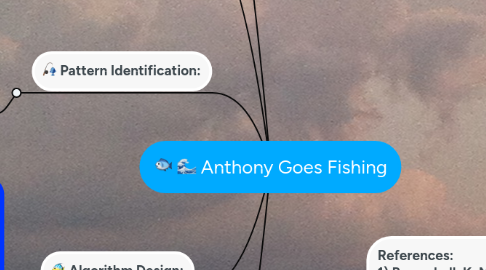
1. Problem:
1.1. Anthony and his wife Kimberly are on vacation in Atlantic Beach, North Carolina. It's looking to be a beautiful, sunny day, and Anthony decides he'd like to go fishing to catch dinner, while Kimberly heads to the beach to enjoy some relaxing reading time. Though Anthony is familiar with different saltwater fish species and fishing in general, he isn’t always sure where to find fish when he’s out on his boat in unfamiliar waters. His fish finder only shows marine life that is within a 100 foot area of his vessel and he doesn't want to be motoring around wasting the day away without any bites.
2. Decomposition:
2.1. In order to make this a successful fishing adventure, Anthony needs to break down the overall problem into smaller, manageable parts. Anthony decides to head to the fishing docks near his AirBnb to see if any locals have tips for him. He talks with a fisherman, cleaning his catch of the day, who informs Anthony that the bigger, tastier fish tend to spend time around structures under water (also known as artificial reefs). Knowing that Anthony is unfamiliar with the area’s waters, the local fisherman suggests he download the app called, Navionics, which provides waypoints (coordinates) for artificial reefs along the U.S. coastlines. Here, Anthony is able to brows dozens of different artificial reefs along the North Carolina coast, thus narrowing down locations and saving time which he could've otherwise been spending blindly looking for fish.
2.1.1. Rationale: Following Google's definition of decomposition, this scenario decomposes Anthony's issue of finding the fish has been broken down into a couple different steps. First, he needs to find someone with local fishing knowledge, next, he needs to learn where to find good fish to catch, and finally, he needs a means of being able to locate said place using coordinates so that he's not wasting daylight motoring around, hoping he happens upon these spots. (Google, no date)
3. Pattern Identification:
3.1. After browsing through the reef locations along the coast on the app, Anthony notices a pattern, indicating that previous fishermen logged catching smaller fish at the reefs closer to shore, whereas anglers who motored out to reefs farther off shore, tended to catch bigger fish.
3.1.1. Rationale: This scenario is an example of the pattern recognition concept, following Google's definition. Using the app's input from previous fishermen, Anthony is able to identify a pattern between the size of the fish and the depth at which they were caught (Google, no date).
4. Algorithm Design:
4.1. Anthony decides to choose a shipwreck 12 miles off the coast. As noted by previous fishermen in the app, this artificial reef, along with a few others around the same area, proved to have similar fish species and a fairly consistent range in the sizes of fish. Anthony inputs the waypoint into his boat’s GPS, and sets off on his fishing trip. Sure enough, as he arrives at his destination, his fish finder picks up a large object 50 feet below, which Anthony assumes is the shipwreck his Navionics app informed him about. He also sees lots of marks indicating that he made a good choice to fish over an artificial reef. Anthony has a successful fishing trip, catching several Red Snapper and Sheepshead.
4.1.1. Rationale: Following Google's definition of the algorithm design concept this example shows that Anthony's use of artificial reef waypoints allowed him to find fish to catch. Because of the depth of the reef, he was able to catch bigger fish (Google, no date).
5. Abstraction:
5.1. Anthony realizes that it's possible to find good fishing locations for both small and larger fish, especially when he anchors his boat over an artificial reef. For example, if Anthony wanted to find smaller fish to use as bait, he could locate a reef closer to shore to acquire them, and then head to a reef farther off shore and use his bait for the bigger fish in deeper waters. He looks forward to utilizing this app and his new fishing knowledge on his next beach vacation.
5.1.1. Rationale: This scenario is an example of the abstraction concept following Google's definition. If an angler utilizes the coordinates of artificial reefs, they will be able to find fish to catch. If they wish to find small fish, they should choose a reef in shallower water, and for bigger fish, a reef in deeper water (Google, no date).

